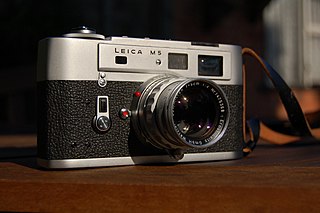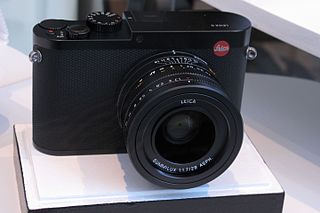
A rangefinder camera is a camera fitted with a rangefinder, typically a split-image rangefinder: a range-finding focusing mechanism allowing the photographer to measure the subject distance and take photographs that are in sharp focus.

Leica Camera AG is a German company that manufactures cameras, optical lenses, photographic lenses, binoculars, and rifle scopes. The company was founded by Ernst Leitz in 1869, in Wetzlar, Germany. The name Leica is derived from the first three letters of the founder's surname (Leitz) and the first two of the word camera: lei-ca.

The Leica M8 is the first digital camera in the rangefinder M series introduced by Leica Camera AG on 14 September 2006. It uses an APS-H 10.3-megapixel CCD image sensor designed and manufactured by Kodak.

The Leica M mount is a camera lens mount introduced in 1954 with the Leica M3, and a range of lenses. It has been used on all the Leica M-series cameras and certain accessories up to the current film Leica M-A and digital Leica M11 cameras.

The Leica CL is a 35mm compact rangefinder camera with interchangeable lenses in the Leica M-mount. It was developed in collaboration with Minolta who manufactured it. It first appeared in April 1973 and was released in the Japanese market in November 1973 as the Leitz Minolta CL. Both the Leica CL and Leitz Minolta CL were manufactured in a new Minolta factory in Osaka. In 2017, Leica announced a new digital mirrorless camera, again named Leica CL.

The Konica Hexar RF is a 35 mm rangefinder camera which was sold by Konica. It was introduced to the market on 13 October 1999. and subsequently discontinued some time before the end of 2003. The camera used the "Bayonet Konica KM-mount", a copy of the Leica M-mount, thus sharing interchangeable lenses with those designed for Leica cameras and others compatible with them. The Hexar RF has a combined rangefinder/viewfinder modeled on that of Leica cameras, a similar body shape and size - and so is similar to Leica M-mount cameras in many aspects of operation.

The Konica Hexar is a 35 mm fixed-lens, fixed focal length autofocus camera which was produced through the 1990s. It was introduced to the market in 1993. While styled like a rangefinder camera, and intended for a similar style of photography, in specification it is more like a larger "point and shoot" camera.

The Bessa family of cameras was manufactured in Japan by Cosina as a revival of the Voigtländer brand name between 1999 and 2015.

The Leica M5 is a 35 mm camera by Leica Camera AG, introduced in 1971. It was the first Leica rangefinder camera to feature through-the-lens (TTL) metering and the last to be made entirely in Wetzlar by hand using the traditional "adjust and fit" method.

The Leica M-E is a digital rangefinder camera manufactured by Leica Camera. It was released on 17 September 2012. The M-E is Leica's first entry-level rangefinder model, with a technical specification that is nearly identical to the Leica M9, and based around the same 18MP full frame CCD sensor. It does not offer the M9's built-in USB port, but keeps pace with an identical 2 frames per second continuous shooting mode, hot shoe and Leica's classic rangefinder design. The M-E does not have a frame-lines lever, it preselects the correct frame-line for any lens when it is attached. The M-E, like the M9 and the M Monochrom, was made of brass around a magnesium chassis. The M-E is only available with an anthracite grey paint finish.

The Leica M is a full-frame digital rangefinder camera of Leica Camera AG. It was introduced in September 2012, and is the successor to the Leica M9 range of cameras. The M uses a 24-megapixel image sensor. The camera is the first M model to feature movie recording, and the first to have Live View, which allows the scene, as viewed through the lens, to be composed. The M can use most M- and R-mount lenses. Leica M cameras are made by hand in Portugal and Germany. There is also a version, the M Monochrom, with a monochrome, rather than colour, sensor.

The Leica Q is a full-frame fixed-lens camera announced by Leica on June 10, 2015. The Leica Q2 was announced in March 2019.

The Leica M10 is a full-frame digital rangefinder camera in Leica Camera AG's rangefinder M series. It accepts Leica M-mount lenses. The camera model was introduced on 19 January 2017. It is a successor to the Leica M9; and has similarities with and differences to the Leica M, Leica M, and Leica M Monochrom. There are five variants of the M10 line—the M10,M10-P,M10-D, and M10 Monochrom and M10-R.
The Leica M-A is a purely mechanical 35 mm rangefinder camera released by Leica Camera AG in 2014. The camera has no exposure meter, no electronic control, and no battery is required to operate it. The camera is Leica's first purely mechanical camera since the release of the Leica M4-P in 1981.
The Leica M-E is a digital rangefinder camera announced by Leica Camera on June 24, 2019. The Leica M-E is part of the long running Leica M mount line. It features a 24 Megapixels full-frame CMOS sensor, Leica's Maestro processor, and a 2GB buffer for sustained burst capture. Video can be captured at 1080/30p. As with all Leica M-series models, the camera is hand-built and weather-sealed. The camera is finished in "Anthracite Paint" with black leather wrap and limited to 700 units worldwide.
The Leica M Monochrom is a digital rangefinder camera manufactured by Leica Camera. It was released on 30 April 2015. The Leica M Monochrom uses a full frame 24 Megapixels CMOS sensor that, like its predecessor the Leica M Monochrom, has no color filter array. It is therefore Leica's second black and white only camera. It is essentially a monochrome only version of the Leica M. The M Monochrom offers an increase in ISO range up to ISO 25,000, a new 3 inches 921,000-dot LCD screen and live view shooting including focus peaking and 10x magnification. Also included is full HD video recording.

The Leica M-D was a digital rangefinder camera released by Leica Camera on 28 April 2016. The M-D is the second digital camera in the Leica M mount line-up without the rear LCD screen. The first such camera was the Leica M Edition 60 that founded on 16 September 2014, and was released to mark the sixtieth anniversary of its Leica M rangefinder system. Only 600 of these models were made, and were sold for about $18,000/£12,000. The M-D however was a full production model. The camera went on sale in May 2016 with a price of $5995/£4650.

The Leica M10-D is a digital rangefinder camera released by Leica Camera on 24 October 2018. The M10-D succeeds the Leica M-D in the Leica no-LCD screen line of digital cameras. Otherwise the M10-D is similar to the Leica M10.

The Leica M10 Monochrom is a digital rangefinder camera manufactured by Leica Camera. It was released on 17 January 2020. A black and white only successor to the Leica M Monochrom and the Leica M Monochrom. The M10 Monochrom uses a full frame 40 Megapixels CMOS sensor that has no color filter array on the sensor. The Leica M10 Monochrom is physically similar to the Leica M10 and Leica M10-P with a dedicated ISO dial on the top plate. The ISO ranges from 160 to 100,000. The M10 Monochrom has a 3" color TFT LCD monitor with 1,036,800 pixels covered with Gorilla Glass. The camera is made of all-metal die cast magnesium body, wrapped in synthetic leather covering, and brass top panel and base, with black chrome plated finish.


















